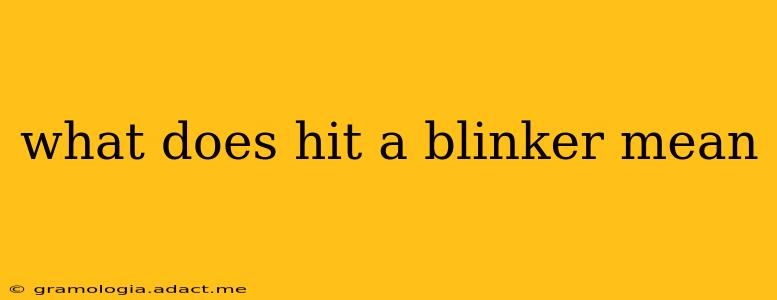What Does "Hit a Blinker" Mean? A Comprehensive Guide to Signaling Your Intentions
The phrase "hit a blinker" is a colloquialism referring to the act of activating a vehicle's turn signal, also known as a blinker, indicator, or flasher. It's a simple action with significant implications for road safety and courtesy. This guide will explore the meaning, importance, and nuances of hitting your blinker, addressing common questions along the way.
What is the purpose of using a turn signal?
The primary purpose of using your turn signal (or "hitting your blinker") is to communicate your intentions to other drivers, pedestrians, and cyclists. This clear communication is crucial for preventing accidents. By signaling your lane changes, turns, or stops, you give others sufficient time to react and adjust their behavior accordingly, creating a safer and more predictable driving environment.
Why is it important to signal before changing lanes or turning?
Failing to signal before changing lanes or turning is not only inconsiderate but also extremely dangerous. It can lead to collisions, near misses, and even serious injuries. Drivers need ample warning to anticipate your movements, particularly at higher speeds or in heavy traffic. A simple blinker activation can be the difference between a smooth maneuver and a potentially disastrous accident.
When should I use my turn signals?
You should use your turn signals in virtually every situation where you're changing your vehicle's direction or position on the road. This includes:
- Lane changes: Always signal before changing lanes, even if it seems obvious to you.
- Turns: Signal well in advance of turning, giving other drivers sufficient time to react.
- Merging onto a highway: Signal your intention to merge before entering the highway flow.
- Stopping or slowing down significantly: Signaling your intent to stop, especially in situations where it's not immediately apparent (like slowing for a pedestrian), can be critical for preventing rear-end collisions.
- Pulling over to the side of the road: Signal your intention to pull over to allow ample time for following vehicles to react and avoid a collision.
What happens if I don't use my turn signals?
Depending on the jurisdiction, failure to signal can result in traffic violations and fines. More importantly, however, it can lead to dangerous driving situations and accidents, potentially causing injury or property damage. Remember, signaling is about more than just avoiding a ticket; it's about driving responsibly and safely.
Are there any specific situations where signaling is particularly important?
Yes, there are several scenarios where signaling is critical for safety:
- Intersections: Always signal your intentions at intersections, even if you have a green light.
- Construction zones: Use your signals diligently in construction zones, as traffic patterns may be unpredictable.
- Bad weather conditions: Signaling is crucial in poor weather as visibility is reduced, and drivers may need more time to react.
- Heavy traffic: Clear signaling helps maintain the flow of traffic and prevents accidents in congested areas.
What if my blinker is broken?
If your blinker is broken, you need to get it repaired immediately. In the meantime, you should use other methods to signal your intentions, such as hand signals, if permitted and safe in your location. Clearly communicating your intentions is paramount, regardless of your equipment's condition.
In conclusion, "hitting your blinker" is not just about following traffic laws; it's about being a responsible and considerate driver. By consistently using your turn signals, you contribute to a safer driving environment for yourself and others. Remember to always signal your intentions clearly and well in advance of any maneuver.
